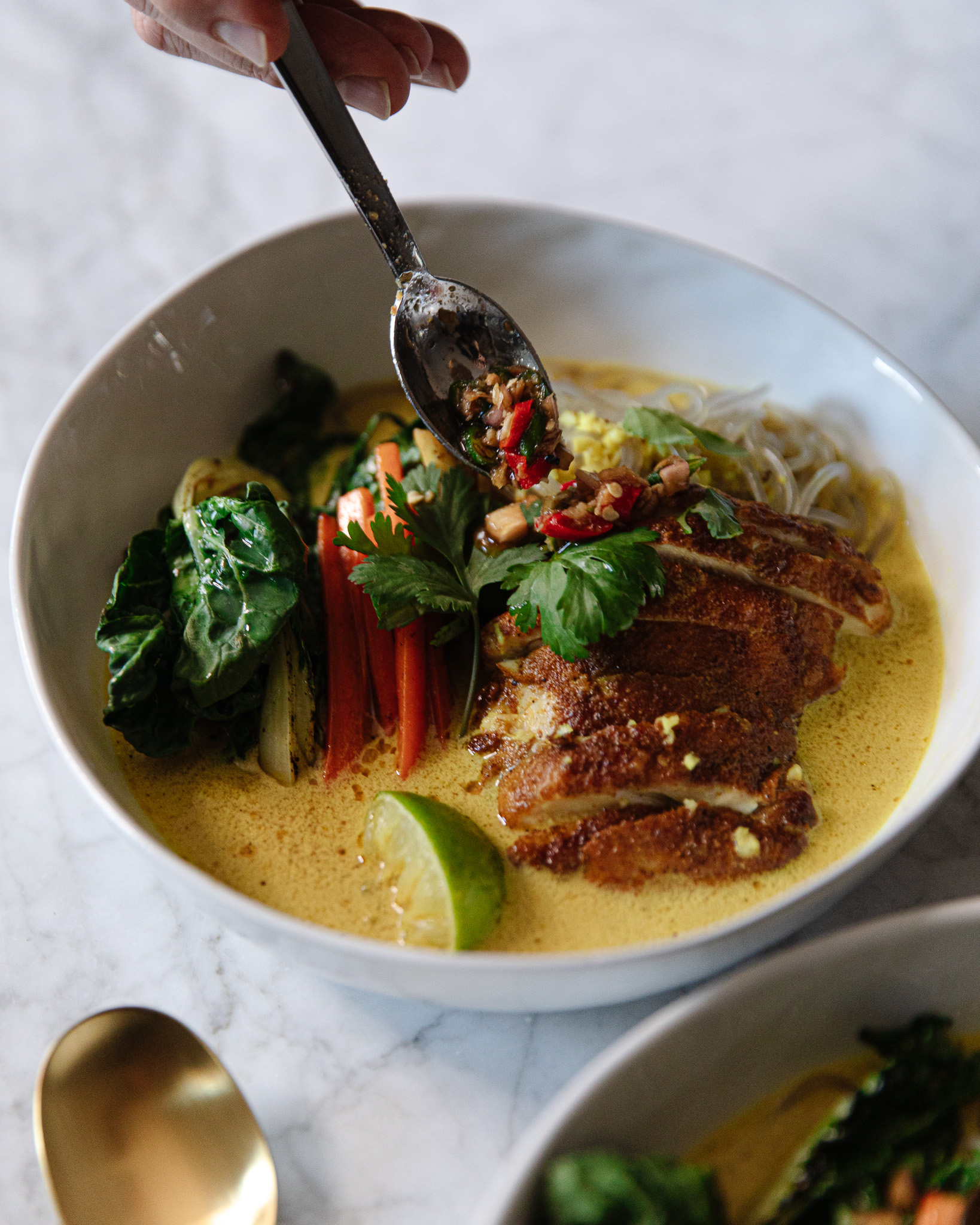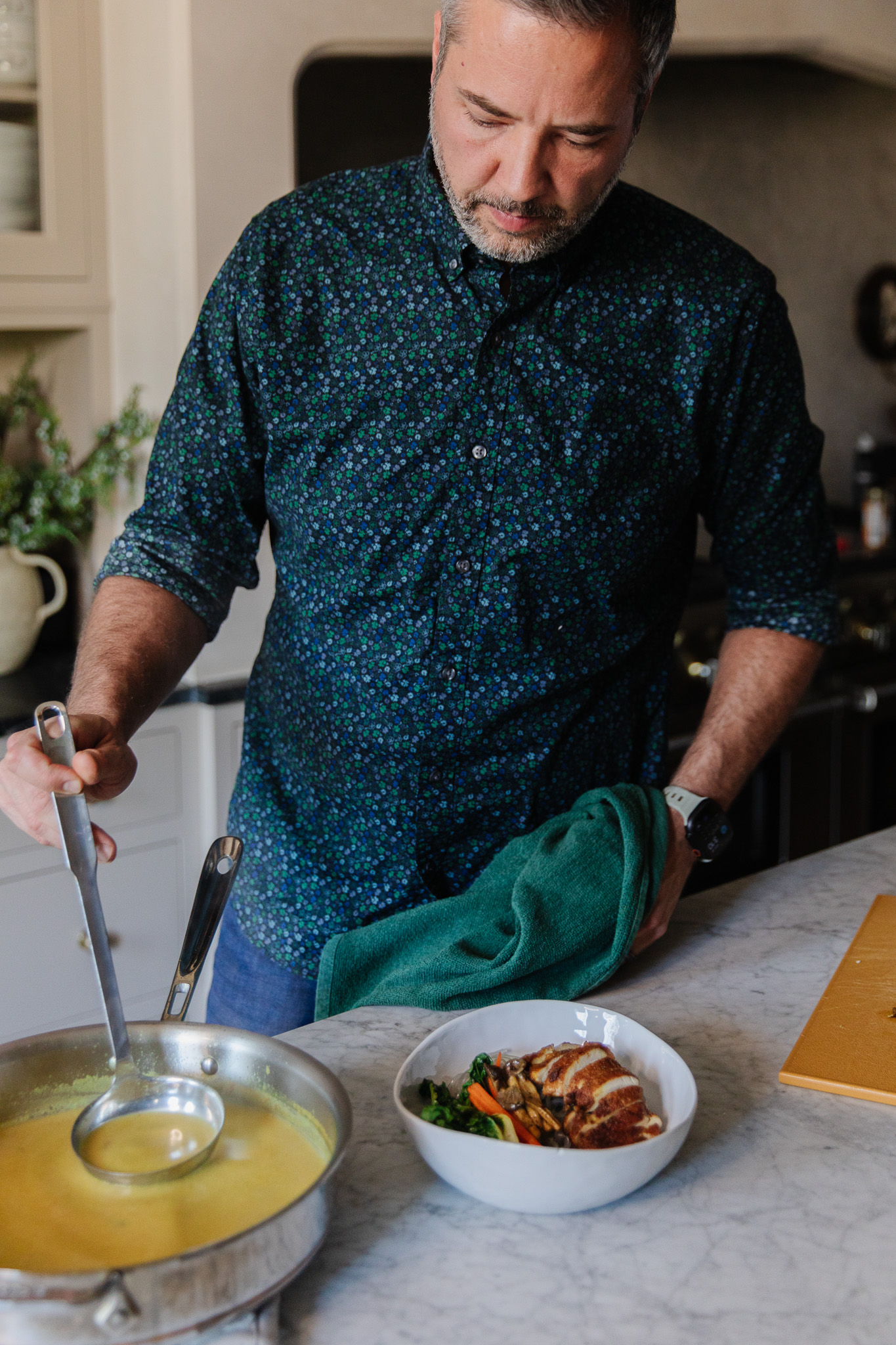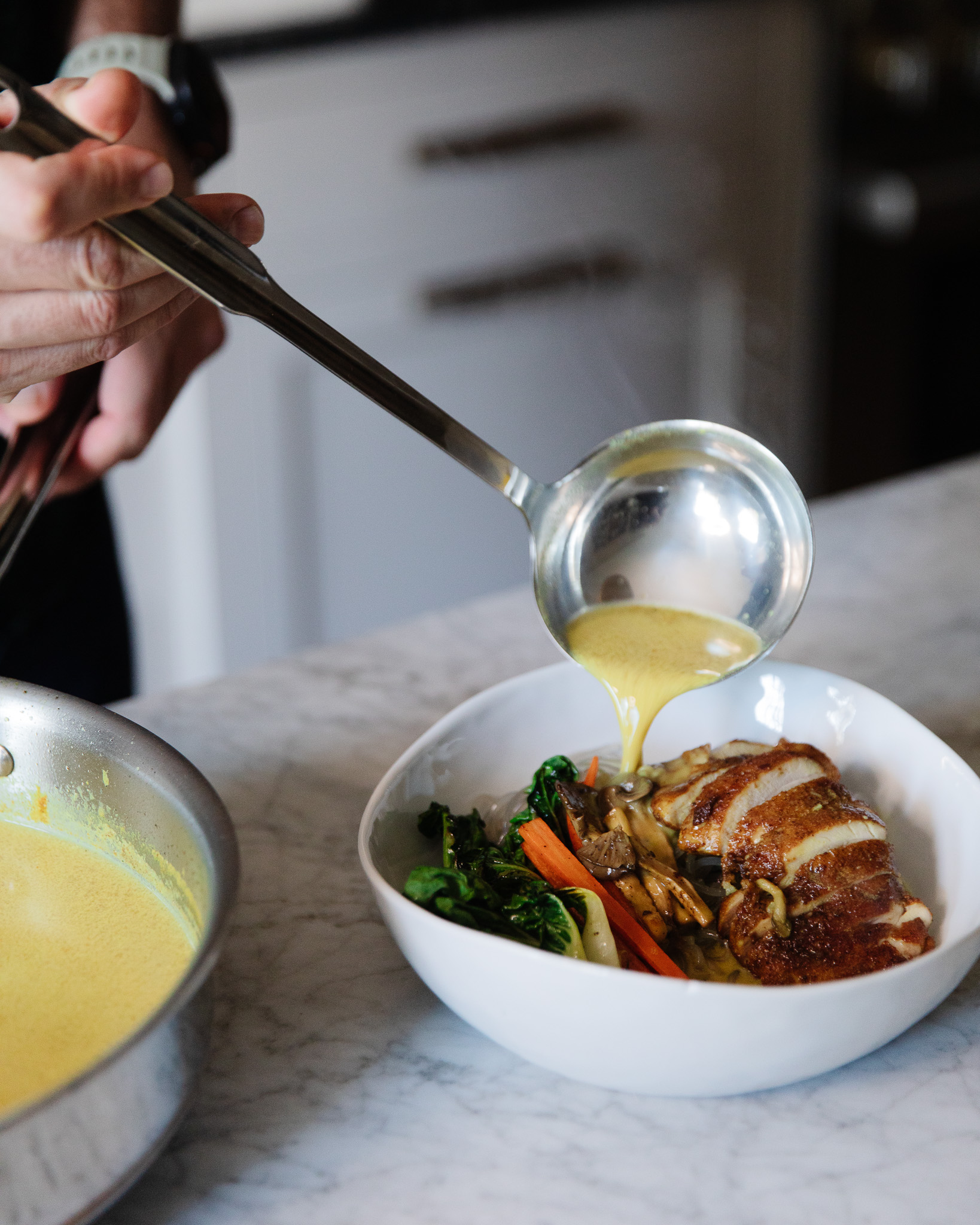This is the soup I want when I’m feeling on the verge of “under the weather”—not quite sick, but the cold outside is draining me a little bit. There’s the feeling that you could get sick. That’s when you want a spicy soup. I like this chicken noodle soup with the flavors of Singapore noodles: it has just this. deeply warming feeling plus the benefits of bone broth. The flavor of the coconut milk, garlic, and the heat of the curry clear the sinuses, especially if you go with the spicy version. Plus it’s dairy- and grain-free!
Why is the original dish called Singapore noodles? Many swirling theories are out there, so I’m not entirely certain. But it’s really not a dish from Singapore at all. It’s likely a Cantonese-style stir fry featuring curries that were carried via the spice trade from British-ruled India. I have not been to the region, but it’s a dream of mine to travel all through southeast Asia and try so many of its tasty foods. I digress…let’s get cooking.
A tip on working with glass noodles

This dish uses glass noodles (also called cellophane noodles or fensi) which are made of starch—often times mung bean flour or sweet potato.
Glass noodles are great for soup but they can’t sit in the liquid too long or they become gummy. So I recommend making them ahead of time according to the package you’re using, and then chill them and toss them with a little sesame oil and fish sauce. Then they can stay at room temperature until you’re done making the soup.
Which to use: Madras vs. regular curry powder
Use a curry powder that reflects how spicy you want the final dish to be. If you want it to be a medium spice level (my preference here), then use a Madras curry powder. If you want it mild, use a regular curry powder. I love to find spices at H-Mart, and my favorite one for this curry is from the brand Cà Ri Nị Ấn Độ – Sing Kung Corp. You can also find it on Amazon!
How to Make This Chicken Noodle Soup

Shop Chris’s Favorite Kitchen Tools
After you have the noodles cooked to the package directions, you can go ahead and portion them out in your serving bowls, since you will assemble the soup right there at the end.
As far as equipment, you need a high-sided saute pan (or even a wok). I’m using this 10-inch one. Add some coconut oil to the pan and set it over medium heat. Dust and coat the exterior of the boneless and skinless chicken thighs with your curry power of choice. Sear them in the pan, turning once, until they’re cooked to 160 degrees, approximately 5-7 minutes per side. The carryover cooking that happens off the heat will take it up to the ideal 165 degrees. They’ll have this rich brown color on the exterior and will be very juicy. Set the chicken thighs aside to rest while you start on the vegetables
Use the same pan you just used for the chicken—no cleaning it out!—to saute the carrots lightly with a quarter of a pinch of salt, which will develop color and flavor. Then we’ll saute the baby bok choy cut side down in the pan—get a little char on the bottom—and then the oyster mushrooms separately just until they have some caramelized edges, removing them to a platter. Add a couple of tablespoons of chicken stock to the mushrooms if they’re getting too dry in the pan. Each will take about a minute and a half to sear.
Next in that same pan, build the broth, starting with the lite coconut milk (I’m using the Chaokoh brand). Season this with salt or 1 1/2 teaspoons of fish sauce to taste. Turn the temperature up and whisk the mixture to break up the fond on the bottom. Add the minced garlic, 1/2 teaspoon of turmeric, and about 3/4 teaspoon more curry powder. Whisk in chicken stock and bring the mixture to a boil. Taste and adjust the seasoning. Let it simmer for 10 minutes to meld the flavors together.
How to Serve this Singapore Noodles-Inspired Soup

Place a sliced chicken thigh over the noodles in one of the bowls. Then add a few baby bok choy to another side of the bowl. Sprinkle some carrots in between them and add some mushroom pieces. Take your pan and a ladle and scoop four ladles of the broth into each bowl, sprinkle over a few cilantro leaves and squeeze a key lime overtop, dropping in the spent lime for extra flavor.
I made a sweet-spicy chili sauce to accompany this since I like to add the heat. It’s a blend of Thai chili peppers, garlic, sugar, and lime juice creating a unique balance of sweet and spicy. When this dish is cooked, it’s not quite as spicy to me, so I’ll add in a little sauce. Just be careful with it—a little goes a long way. It’s concentrated everything: sweet, spicy, savory—it’s a big flavor bomb.
What can I substitute for…
Mushrooms: You can use any variety that you want just slice them pretty thin.
Fish sauce: If you want to skip the fish sauce, you can substitute salt in a 1:1 ratio.
Coconut milk: You can use almond milk or soy milk if you prefer.
Key limes: I like to use key limes—it’s more about the size, but also key limes always juice consistently. They’re the perfect amount of lime juice for a portion. You can use regular limes if that’s what you have available, just use half for both portions.
Madras curry powder: You can switch to a regular curry powder (look for no chili peppers in the ingredients list). If you want MORE spice to it, add some Asian hot sauce.
Can you make this dish ahead of time?
You can make all of the components ahead of time, store them in the refrigerator for up to a few days. Then reheat the chicken, vegetables and broth—no need to reheat the noodles—and assemble the soup at the table. The most important thing is to wait until serving to add the broth!

Shop The Kitchen
You just can’t beat the warm, spicy smell from this soup that permeates the room and lifts your senses. I hope you make it for someone you care about and let me know how it goes in the comments!

